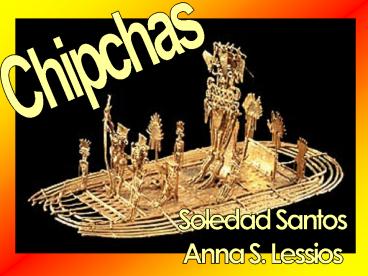Chipchas - PowerPoint PPT Presentation
1 / 8
Title: Chipchas
1
Chipchas
Soledad Santos Anna S. Lessios
2
Background Information
- Called by the spaniards Muiscas, Muxicas, or
Mozcas. - Between 400 and 300BC the Chibchas traveled from
Nicaragua and Honduras to Colombia, right before
the Arawaks arrived there from other parts of
South America. - First they settled in the low lands of Colombia
but then were forced to move to the mountains by
the Caribs. - Chibchas lived in the eastern and north-eastern
highlands of Colombia but resided mostly in the
Colombian Andes. - In the 16th century they occupied what is
currently the Colombian departments of Boyaca and
Cundinamarca..
3
Political Structure
- The executive branch was lead by an elected
war-chief called the Zaque. - The Chibchas territory was divided into two major
federations - One federation under the authority of the Zipa of
Bacata (close to whats currently Bogota). - The other under the Zaque of Hunsa or Tunja.
- Each federation contained a dominant city
(capital city) and smaller towns. Caciques
governed these areas. - The two federations paid allegiance to the high
pontiff (sacred priest) of Sogamozo or Iraca. - Apart from the two major federations, the
Chibchas also had seven smaller states.
4
Economic Stucture
- Main source of economic gain was agriculture.
- - Main bases of activity were corn, cotton,
coca, potatoes, and tobacco. - Chibchas used salt and emeralds as their
currency. - They created large commercial routes that
extended to Peru and Panama and were used to
trade mostly salt. - They used their gold to adorn the higher
political figures with of large and precious
jewelry. - Their commercial structure was very developed and
included markets, fairs, and a weight and measure
system.
5
- They believed the shamans were capable of
speaking with their spirits and gods. - They were polytheists, animists, and believed in
the spirits and miracles of nature. - Paid homage to their ancestors and the sun.
- Chibchas believed that the high pontiff was so
powerful that he could control the waters and the
rain, and that the weather depended on his will. - They celebrated their gods with music instead of
prayer, hence the name muisca. - Human and animal sacrifices were very common.
- Most offerings consist of gold, emeralds, and
fruits.
Culture
6
Social Structure
- Role of Women and Men
- Chibchas were polygamists (men were allowed to
marry more than one wife). - The caciques position was chosen through the
maternal line. - For land ownership was determined through the
paternal line. - Working positions and importance
- Priests had an important job which was
maintaining the numerous temples and sanctuaries
also leading the rituals and ceremonies. - Caciques were very important political figures
that controlled and governed the Chibchas smaller
states and villages.
7
Everyday Life
- Shelter and diet
- Houses mostly circular with conic rooftops made
out of hay. - Houses were built out of a wooden structure
covered with clay. - Temples were used for ceremonies and rituals.
Palaces were only for the cacique and huts were
for everybody else. - Chibchas commonly ate the fruits of their labor
and used the surplus for trading. They also
hunted for food. - Working habits
- They spent most of their time working on their
agriculture - 1. Gathered salt
- 2. Sometimes hunted
- Many worked in the army fighting neighboring
tribes and enemies.
8
Spanish Conquest
- In 1536 Gonzalo Ximenez de Quesada began his
exploration in the Colombian Andes invading the
Chibcha territory causing conflicts. - By 1538 the Chibchas had been completely
conquered by the Spaniards. - Spaniards stole most of the Chibchas riches (gold
and emeralds). - After they were conquered the political structure
of the Chibchas deteriorated and their language
was replaced by Spanish.































